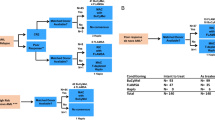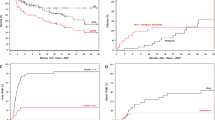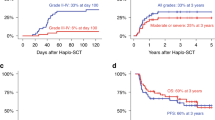Abstract
We prospectively assessed autologous stem cell transplantation for consolidation treatment in a trial of intensive chemotherapy in high risk myelodysplastic syndromes (MDS). In this trial, patients aged 55 years or less with no HLA-identical sibling and achieving CR were scheduled to receive unmanipulated autologous bone marrow transplantation (ABMT) preceded by a consolidation chemotherapy course. Forty-two of the 83 patients aged 55 years or less included in the trial (51%) achieved CR. Three were allografted in CR. Twenty-four of the remaining 39 patients who achieved CR (62%) received ABMT (16 patients) or autologous peripheral blood stem cell transplantation (APSCT) (eight patients). Indeed, as bone marrow harvest was often insufficient, APSCT was subsequently proposed after mobilization by consolidation chemotherapy followed by G-CSF. The conditioning regimen combined cyclophosphamide and busulfan. ABMT and APSCT were performed 1–7 months (median 3) after CR achievement. Hematological reconstitution occurred in all patients and tended to be faster after APSCT than ABMT although not significantly. Three patients died from the procedure, nine relapsed after 2–26 months and 12 (50%) were still in CR after 8–55 months. In autografted patients, median Kaplan–Meier disease-free survival and survival were 29 and 33 months from the autograft, respectively. Thus, ABMT or APSCT can be performed in almost two-thirds of MDS patients who achieve CR with intensive chemotherapy. PBSC collection may yield higher numbers of stem cells than marrow collection in some cases, and could improve the percentage of MDS patients autografted in CR. Longer follow-up is required to determine if autograft will prolong CR duration in at least some patients.
This is a preview of subscription content, access via your institution
Access options
Subscribe to this journal
Receive 12 print issues and online access
$259.00 per year
only $21.58 per issue
Buy this article
- Purchase on Springer Link
- Instant access to full article PDF
Prices may be subject to local taxes which are calculated during checkout
Similar content being viewed by others
Author information
Authors and Affiliations
Consortia
Rights and permissions
About this article
Cite this article
Wattel, E., Solary, E., Leleu, X. et al. A prospective study of autologous bone marrow or peripheral blood stem cell transplantation after intensive chemotherapy in myelodysplastic syndromes. Leukemia 13, 524–529 (1999). https://doi.org/10.1038/sj.leu.2401387
Received:
Accepted:
Published:
Issue Date:
DOI: https://doi.org/10.1038/sj.leu.2401387
Keywords
This article is cited by
-
Specific scoring systems to predict survival of patients with high-risk myelodysplastic syndrome (MDS) and de novo acute myeloid leukemia (AML) after intensive antileukemic treatment based on results of the EORTC-GIMEMA AML-10 and intergroup CRIANT studies
Annals of Hematology (2015)
-
A retrospective comparison of autologous and unrelated donor hematopoietic cell transplantation in myelodysplastic syndrome and secondary acute myeloid leukemia: a report on behalf of the Chronic Leukemia Working Party of the European Group for Blood and Marrow Transplantation (EBMT)
Leukemia (2007)
-
Autologous stem cell transplantation for therapy-related acute myeloid leukemia and myelodysplastic syndrome
Bone Marrow Transplantation (2006)
-
Mesenchymal cells generated from patients with myelodysplastic syndromes are devoid of chromosomal clonal markers and support short- and long-term hematopoiesis in vitro
Oncogene (2005)
-
Myelodysplasia – therapeutic response to novel therapy and the need for new diagnostic groups
Leukemia (2003)



